The real-life Day After Tomorrow? The Gulf Stream is weakening thanks to climate change – and it could plunge Europe into a deep freeze if it collapses, scientists warn
In 2004, The Day After Tomorrow might have seemed like nothing more than a far-fetched climate disaster movie.
But scientists warn that this movie could soon become reality, A new study shows that climate change could plunge Europe into a deep freeze.
Researchers from University College London have discovered that the Gulf Stream, a major current of warm water, could be particularly sensitive to changes in climate.
Their research shows that global warming could lead to a collapse of the Gulf Stream, causing temperatures in Europe to drop by as much as 15°C (27°F).
Lead researcher Dr Jack Wharton said: ‘If winds weaken in the future, as suggested by a recent study using climate models, this could lead to a weaker Gulf Stream and a cooler Europe.’
In 2004, The Day After Tomorrow may have seemed like just another far-fetched climate disaster movie. But now scientists are warning that this movie could soon become a reality
The Gulf Stream is a current of warm water that flows along the east coast of North America and across the Atlantic Ocean to Europe.
Upon arrival, heat energy is released into the atmosphere, keeping temperatures in Europe higher than they would otherwise be.
Some research has already shown that the ocean current patterns that shape our planet’s climate are weakening.
To understand how a major change in climate conditions could affect the Gulf Stream in the future, researchers had to look far back in time.
About 20,000 years ago, the planet was in the grip of the last Ice Age, which covered much of the Northern Hemisphere in a thick ice cap.
However, researchers now believe that despite the surrounding climate, Europe was kept warm by an exceptionally strong Gulf Stream.
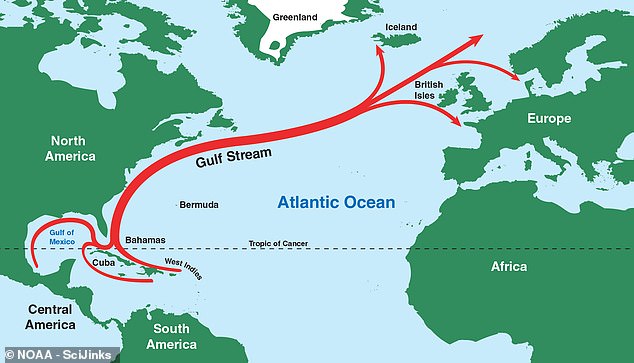
The Gulf Stream is a strong current that carries warm water from the tropics along the coast of North America, across the Atlantic Ocean and to Europe
Researchers collected sediment samples along the coasts of North Carolina and Florida to look for the presence of ancient microorganisms called foraminifera.
Co-author Professor David Thornalley told MailOnline: ‘The fossils of foraminifera that lived during the last ice age were used because the chemical composition of their shells records the density of the water they lived in when they were alive.’
Because the water in the Gulf Stream is very warm, it has a lower density than water from the subpoles. The researchers were able to use the density recorded by the shells to determine where the Gulf Stream would have flowed.
Because this faster flow can carry larger pieces of material, the researchers also looked at the different grain sizes in the sediment to determine its speed.
Based on their measurements and some ocean physics, the researchers calculated that the Gulf Stream was twice as deep and twice as fast at the time as it is today.
Dr Wharton says: ‘We found that the Gulf Stream was much stronger during the last ice age because of stronger winds in the subtropical North Atlantic.
‘As a result, the Gulf Stream continued to move a lot of heat north, while the rest of the planet was much colder.’
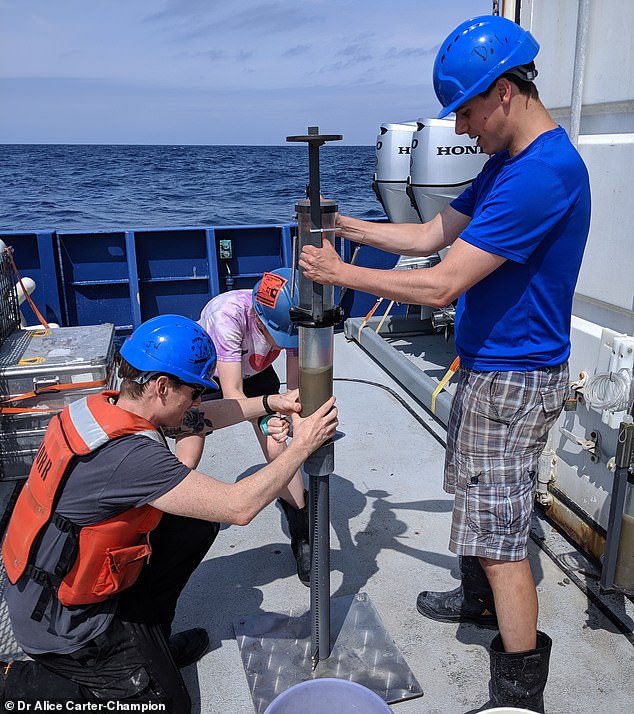
Scientists used sediment samples from North Carolina and Florida (pictured) to determine how strong the Gulf Stream was during the last ice age, revealing that global currents are highly sensitive to climate change.
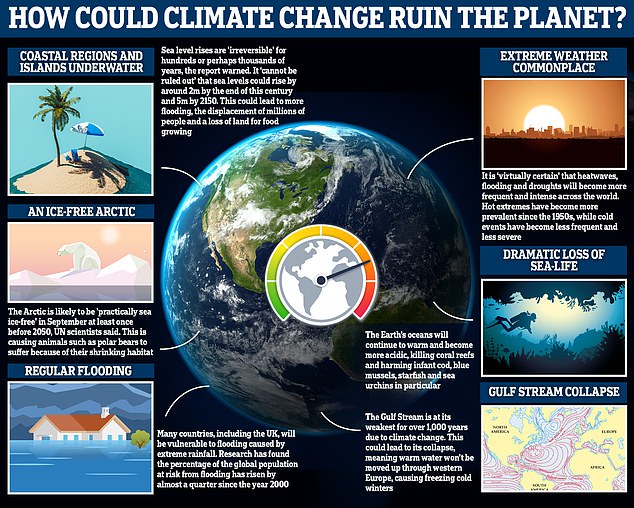
If temperatures continue to rise, there could be devastating consequences for the Earth, including a dramatic loss of marine life, an ice-free Arctic and more frequent ‘extreme’ weather.
These findings have worrying implications for our future, as they indicate that the strength of the Gulf Stream is dependent on climate factors.
Professor Thornally told MailOnline: ‘The ocean moves huge amounts of heat around the world – the equivalent of the energy from millions of power stations.
‘Changing the strength of ocean currents can therefore change how much heat goes where. This changes our climate, and on shorter timescales, our weather.’
The Gulf Stream itself is just one part of the Atlantic Meridional Overturning Circulation (AMOC), a vast network of currents that pumps warm water around the world.
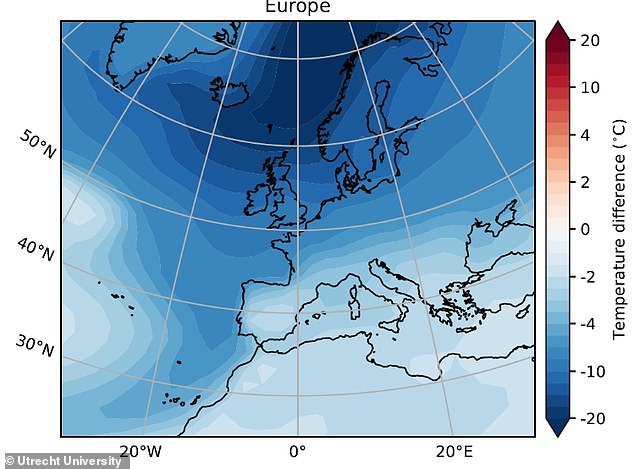
Previous research (see figure) shows that the collapse of a large system of ocean currents called the AMOC could lead to a temperature drop of more than 3°C per decade.
Although often described as a conveyor belt, Professor Thornally says it is better to think of AMOC as “a series of interconnected loops”.
He adds: ‘There’s the subtropical loop, which includes the Gulf Stream, and a subpolar loop, which transports heat further north to the Arctic.
‘Our findings show that the subtropical loop was stronger during the last ice age than it is today, while the subpolar loop is thought to have been weaker.’
One of the biggest concerns is that rising global temperatures will disrupt the engine of the subtropical loop.
When ocean water hits the ice around Greenland in the subpolar North Atlantic Ocean, it cools rapidly and becomes extremely dense and salty.
This causes the water to crash down, pulling the hot water with it and creating an extended circulation pattern.
But as the fresh water from the Greenland ice sheet melts, the cold salty waters become diluted and less dense.

Just like in the Hollywood blockbuster The Day After Tomorrow (pictured), the collapse of the Gulf Stream could lead to rising sea levels and a deep freeze
Some research suggests that this could slow the rotation speed of the subtropical loop and weaken the Gulf Stream.
The authors of this paper point out that recent studies indicate that climate change is already weakening the strong North Atlantic winds that drive the Gulf Stream.
Co-author Professor Mark Maslin said: ‘The extent to which ocean currents are responsible for transferring heat around the planet and shaping our climate is not always recognised.
‘Paradoxically, climate warming could cool much of Europe by disrupting the AMOC.’
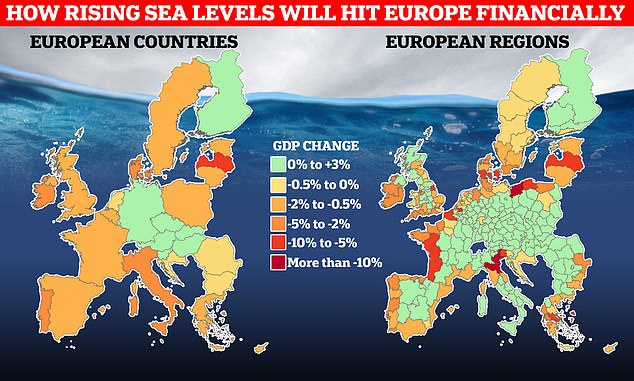
The costs of rising sea levels are subtracted from a country’s gross domestic product (GDP). This map shows the countries most affected (with the largest decline in GDP due to the costs of rising sea levels) in red and orange, with the least affected countries in green
While researchers say they are not sure how big an impact this will have, in the unlikely event that the Gulf Stream collapses completely, temperatures in Europe could drop by 10 to 15°C (18-27°F).
The researchers point out that current climate models show that a weakening Gulf Stream would have “devastating effects” on continental agriculture and weather patterns.
And just like in the movie The Day After Tomorrow, the researchers say this could also lead to rising sea levels in North America.
Professor Thornally adds: ‘Changes in AMOC will also lead to changes in sea level around the North Atlantic, with significant rises (tens of centimetres) along the east coast of North America.
‘But even a more modest weakening of AMOC will still change the direction in which heat travels, disrupting our normal weather patterns and likely leading to more extreme weather events, such as floods, heat waves and droughts.’
This article is published in Nature.
